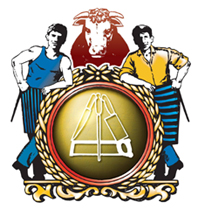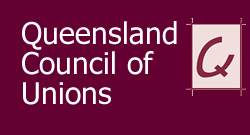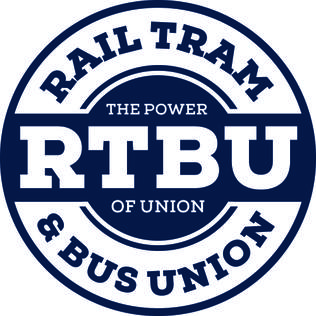
The Shop, Distributive and Allied Employees' Association (SDA) is the largest private sector trade union in Australia, with 203,867 members as at 30 June 2019. It has branches in every state and territory representing retail, fast-food and warehousing workers.

The Australasian Meat Industry Employees Union is an Australian trade union representing workers in the meat industry including in abattoirs, butchers, and smallgoods manufacturers.

The Australian Manufacturing Workers Union (AMWU), or more fully the Automotive, Food, Metals, Engineering, Printing and Kindred Industries Union, is an Australian trade union. The AMWU represents a broad range of workers in the manufacturing sector, as well as associated industries, and is affiliated to the Australian Council of Trade Unions.

Transport Workers Union of America (TWU) is a United States labor union that was founded in 1934 by subway workers in New York City, then expanded to represent transit employees in other cities, primarily in the eastern U.S. This article discusses the parent union and its largest local, Local 100, which represents the transport workers of New York City. TWU is a member of the AFL-CIO.

The Australian Workers' Union (AWU) is one of Australia's largest and oldest trade unions. It traces its origins to unions founded in the pastoral and mining industries in the 1880s and currently has approximately 80,000 members. It has exercised an outsized influence on the Australian trade union movement and on the Australian Labor Party throughout its history.

The Queensland Council of Unions (QCU) is a representative, an advocacy group, or peak body, of Queensland trade union organisations, also known as a labour council, in the Queensland, Australia. As of 2020, 26 unions and 13 regional branches were affiliated with the QCU. The QCU represents unions covering around 350,000 Queensland workers. It is affiliated with the Australian Council of Trade Unions (ACTU). Its offices are located in the suburb of South Brisbane, Queensland. As a peak body for the Queensland trade unions, the objective of the QCU is to achieve industrial, social and political justice for Queensland workers. The management structure of the QCU is made up of a committee of management and an executive of representatives comprised from affiliated unions.

The Australian Rail Tram and Bus Industry Union (RTBU) is a powerful Australian trade union representing rail, tram and bus workers. The RTBU is affiliated with the Australian Council of Trade Unions (ACTU) and the Australian Labor Party (ALP).

The Australian Services Union is a trade union representing workers in a variety of industries.

The Construction, Forestry, Maritime, Mining and Energy Union is Australia's main trade union in construction, forestry, maritime, mining, energy, textile, clothing and footwear production. The CFMMEU is affiliated with the Australian Council of Trade Unions, with the Australian Labor Party and with the World Federation of Trade Unions.

United Voice was a large Australian trade union, with over 130,000 members. United Voice members worked in a wide range of occupations including hospitality, childcare, teachers' aides, aged care, property services, health, manufacturing, ambulance workers and community services.

The Federated Ship Painters and Dockers Union (FSPDU) was an Australian trade union which existed between 1900 and 1993. It represented labourers in the shipbuilding industry, covering "mostly work associated with chipping, painting, scrubbing [and] cleaning [ships], working in every size of tanks, cleaning boilers, docking and undocking vessels, and rigging work".
Overtime bans are a type of strike in which workers refuse to engage in overtime work, being any work that falls outside of contracted hours. They do this to leverage their employer into negotiating various working conditions. Often organised in unions, workers may choose this form of industrial action to bargain for a higher rate of pay, better working conditions or to discourage an employer from making redundancies. Unlike a full strike in which employees are usually in breach of their contract, workers engaging in overtime bans are typically well protected. Employers cannot legally withhold normal wages during an overtime ban if employees are not breaching the terms of their employment contracts by refusing to do overtime work. However, the legalities of overtime bans do vary between countries. Overtime bans are effective where "industries and organisations run on such habitually high levels of overtime or goodwill that overtime bans … can have a significant and immediate impact upon the availability of a good or service". Historically, unions have at times received criticism on ethical grounds for choosing to enact overtime bans. The literature records the occurrence of such bans from the 1800s and there is documentation of their use in four continents.
The Retail Motor Industry Federation (RMI) represents the interests of motor industry operators in England, Wales, Northern Ireland and the Isle of Man providing sales and services to motorists and businesses. It does not represent businesses in Scotland, which are represented by the independent Scottish Motor Trade Association.
The Dollar Sweets dispute in 1985 was a small industrial dispute with major legal ramifications in industrial relations where an employer resorted to a common law verdict and damages in a case in the Supreme Court of Victoria to resolve a dispute after industrial courts proved ineffective. It was the first time a trade union was forced to pay common law damages to an employer for losses suffered through picketing in Australia. The dispute was also significant for boosting the career of the barrister representing the company, Peter Costello, leading him to stand for federal Parliament and become Treasurer in the Howard Government.
Anthony Vincent Sheldon is an Australian politician and trade unionist. He is a member of the Australian Labor Party (ALP) and has served as a Senator for New South Wales since 2019. He was previously a senior figure in the Transport Workers Union (TWU), serving as state secretary (1999–2008) and national secretary (2006–2019).

The Federated Ironworkers' Association of Australia (FIA) was an Australian trade union which existed between 1911 and 1991. It represented labourers and semi-skilled workers employed in the steel industry and ironworking, and later also the chemical industry.
Railway Unions in Australia organised labour of railway employees in Australia operated under federal and State awards - this is a partial list of known unions. Many of the unions amalgamated over time, creating a complex trail of ancestry for some of the later unions.

The Rail, Tram and Bus Union Victorian branch or RTBU Victoria is the state branch of the RTBU in Victoria. Originally formed in 1993 as the Victorian branch of the Public Transport Union and renamed the RTBU in 1998, the RTBU Victoria today represents nearly 8000 members across Rail Operations, Tramways, Locomotive, Infrastructure and Administrative areas of Victoria's public transport industry.
The Federated Moulders' (Metals) Union of Australia (FMMUA) was an Australian trade union which existed between 1899 and 1983. It represented moulders – skilled tradesmen who fabricated the moulds for casting metal products in foundries. In spite of only organising within a single skilled occupation, which kept total membership low, the vital position of moulders in major industries such as mining, manufacturing and the railways, ensured that the union remained industrially powerful with a reputation for being highly militant.
















